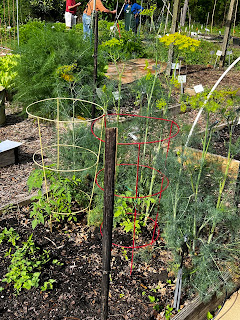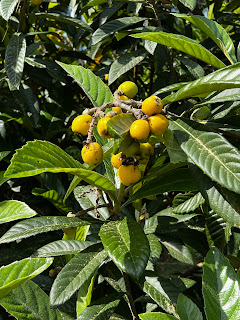 |
Produce from the VegHeadz garden, Yacon
tubers on the right
|
When I was a young girl in North Dakota, my grandfather would listen to the news on the radio at noon. The announcer always ended his broadcast by saying, “It’s a beautiful day in Chicago, and I hope it’s even more beautiful wherever you are.“ Well, yesterday was a beautiful day in Tallahassee and many VegHeadz gardeners were out to enjoy it. We hope you enjoyed it too, wherever you are.
Major amounts of spring weeds were cleared in the forest garden and elsewhere, and more planting and spring cleanup took place all over the garden. Peas were picked and dill harvested. Wouldn’t they be good together?
The bananas were cut back to get them thinned out before spring growth takes off. If there are too many plants in your banana mat, fruit production is affected. Search “bananas” in the right sidebar search box to learn much more about banana plants and how to care for them.
It seems as though the deer which had been munching on our greens and roses have moved on. We are still tying vinegar-soaked rags to a line around beds with vulnerable plants, but we haven’t seen any deer damage in a while. Perhaps because it’s spring they’ve migrated away from the area to more interesting environs, or they learned that our plants just don’t smell good. We hope they remember that if they migrate back next winter.
Peggy and Emma and Carole dug up a big clump of Yacon to propagate for the Spring Plant Sale (May 11). Yacon is a South American plant in the sunflower family that grows well in north Florida. It is a tender perennial which dies back in the winter, but emerges every spring. It is one of the perennial vegetables the VegHeadz have discovered is easy to grow and delicious. Its tubers are sweet, crisp, and juicy, very low in calories and high in protein. Some sources say that eating the roots stimulates bacteria in the digestive system, and that the plants encourage beneficial microbe populations in the soil. The tubers can be eaten raw or cooked, and the leaves make a tea which is reported to be beneficial.
 |
Yacon underground—tuber
on the left, corms on the right |
The plant has two underground growths—the tubers, which are the edible portion and corms, which are used for propagation. The tubers, extending out from the plant in all directions, look like a small to medium size sweet potato with brown skin and white flesh, while the corms tend to be small, pinkish, round, and bumpy, and crowd close together under the plant. The corms the Vegheadz dug yesterday will be potted up so that growing plants will be available at the spring sale.
Yacon only grows about 3 feet tall. It has large, soft, light green, fuzzy, interesting-shaped leaves. It’s really quite a lovely plant which can be grown in your landscape or garden. You need some.
It’s even being considered as a farm crop in Florida
 |
Yacon (Smallanthus sanchifolius)
|
 |
| Emma, Carole, and Peggy, digging and potting up Yacon corms |



















































